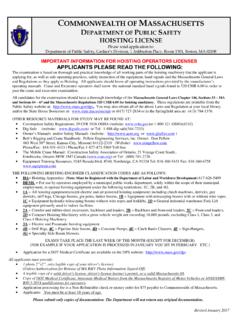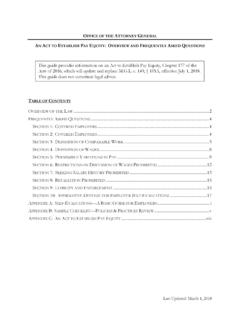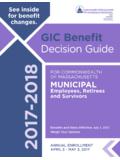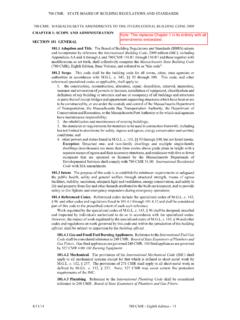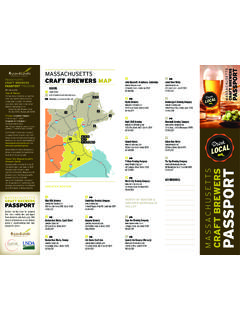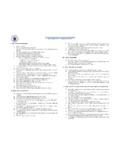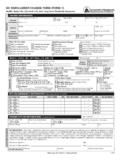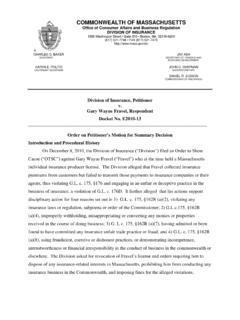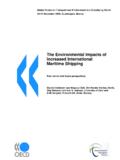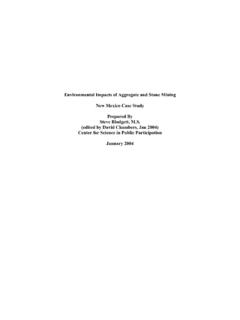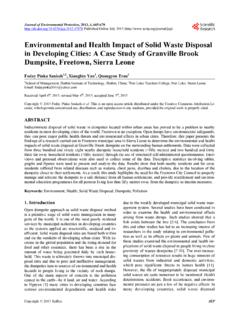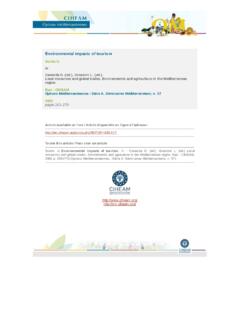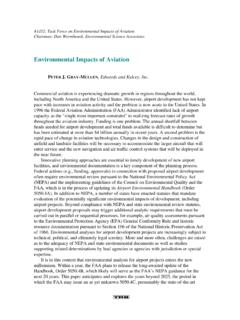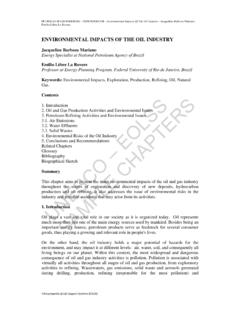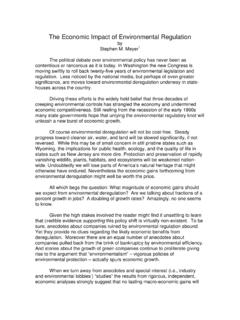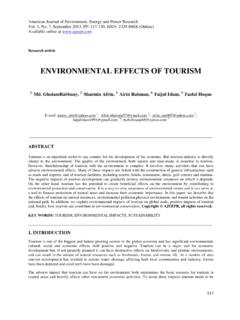Transcription of Large Volume Ethanol Spills – Environmental Impacts and ...
1 Large Volume Ethanol Spills Environmental Impacts & Response Options PPrreeppaarreedd ffoorr:: PPrreeppaarreedd bbyy:: Shaw s Environmental and Infrastructure Group 11 Northeastern Boulevard Salem, New Hampshire 03079 July 2011 ACKNOWLEDGEMENTS The project team instrumental in the development of this document includes the following from Massachusetts Department of Environmental Protection (MassDEP): Nick Child, Central Regional Office, Chief Emergency Response; Dan Crafton, Southeast Regional Office, Chief Emergency Response; Kingsley Ndi, Northeast Regional Office, Chief Emergency Response; David Slowick, Western Regional Office, Chief Emergency Response; Albe Simenas, Boston Office, Chief Emergency Response; and the following from Shaw: Joanne Perwak; Guy Gallello; Vikas Tandon; Dorothy Small; and Charles Schaefer.
2 MassDEP would also like to acknowledge the support and assistance of numerous government agencies and other parties in the development of this report. Local Level Blackstone Fire Department, MA Blackstone Emergency Management, MA Fitchburg Fire Department, MA Everett Fire Department, MA Woonsocket Fire Department, HazMat and Training Divisions Providence Fire Department, RI New London Fire Department, CT Mystic Fire Department, CT State Level Massachusetts Department of Environmental Protection, Emergency Response Massachusetts Department of Environmental Protection, Field Assessment Support Team Massachusetts Department of Environmental Protection, Office of Research and Standards Massachusetts Department of Fire Service.
3 Hazmat Massachusetts Emergency Management Agency Massachusetts State Police Hazmat/Tactical Operations/IMAT Massachusetts Department of Conservation and Recreation, Emergency Response Massachusetts Water Resource Authority, Emergency Response Massachusetts Department of Energy Resources, Alternate Transportation Program/Mass Clean Cities Massachusetts Fish & Wildlife Massachusetts State Emergency Response Commission Rhode Island Department of Environmental Management, Emergency Response Rhode Island Emergency Management Agency Connecticut Department of Environmental Protection, Emergency Response Connecticut Department of Emergency Management and Homeland Security Connecticut Fire Academy Connecticut State Emergency Response Commission Ohio Environmental Protection Agency (state), Emergency Response Pennsylvania Department of Environmental Protection, Emergency Response Illinois Environmental Protection Agency (state)
4 , Emergency Response USF&WS, Environmental Contamination Program, Illinois, USF&WS Oregon Department of Environmental Quality, Emergency Response Federal USEPA Region 1, Emergency Planning and Response USEPA Region 1, Emergency Planning and Community Right-To-Know Act Mike Brazel, NIMS/HazMat Coordinator, US FEMA Federal Railroad Administration, HazMat Division US DOT US Coast Guard, Marine Safety Lab US Coast Guard, Waterways Management, Sector Boston US Coast Guard/National Office of Atmosphere Scientific Support Coordinator, Sector Boston Private Sector/Other Renewable Fuels Association Providence & Worcester Railroad, Rules and Safety Motiva Providence, New England Complex Husky Energy Refinery - NW Ohio, Emergency Response ExxonMobil, Everett, MA Central Mass Homeland Security Advisory Council Table of Contents_____ Executive Summary Scope of Physical and Chemical Characteristics of Ethanol /Gasoline Physical/Chemical DOT Summary of Case Fate and Transport Ethanol Migration Ethanol Degradation Rates.
5 4-2 Methane Generation in Soil/Groundwater ..4-3 Ethanol Partitioning Between Environmental Media Fate and Transport Surface Water ..4-8 Air/Vapor .. 4- 10 Health Effects and Environmental Environmental Risks Fire and Potential Exposure Pathways in spill Human Health Short-Term (Acute) Long-Term (Chronic) Health Protective Environmental Aquatic Terrestrial Health and Safety Considerations for Recognizing Product Exposure Protective Clothing ..5-9 Other Health and Safety Considerations .. 5- 10 spill Assessment and Field Screening Analytical Methods.
6 6-6 Response Options ..7-1 General Short Term Response Priorities ..7-1 Longer Term Response Media Specific Surface Wetlands ..7-9 Marine 10 References ..8-1 List of Tables _____ Table 1-1 Ethanol and Blends and Their Uses _____ 1-2 Table 2-1 Chemical/Physical Properties of Ethanol _____ 2-1 Table 2-2 Comparison of Properties for Ethanol /Gasoline Blends _____ 2-2 Table 3-1 Ethanol spill Incident Summaries_____ 3-1 Table 4-1 Comparison of Fate and Transport of Neat Ethanol with E-Blends_____ 4-1 Table 4-2 Fate of Ethanol after Major Release _____ 4-2 Table 4-3 Effect of Ethanol on Gasoline Fate and Transport in Groundwater _____4-6 Table 5-1 Human Health Effects of Ethanol _____ 5-3 Table 5-2 Health Protective Concentrations _____ 5-4 Table 5-3 Water Quality Benchmarks for Ethanol_____ 5-5 Table 5-4 Ethanol
7 Concentrations Able to Deplete Stream Dissolved Oxygen_____ 5-6 Table 5-5 Ethanol Effects on Wildlife (Select Results) _____ 5-8 Table 5-6 Ethanol Wildlife Benchmarks (Based on No Observed Effect Levels) _____5-8 Table 5-7 Occupational Limits for Ethanol in Air_____ 5-9 Table 5-8 Health and Safety Recommendations for Spills of Fuel Grade Ethanol and E85 _____ 5- 10 Table 6-1 Sampling Techniques _____ 6-2 Table 6-2 Ethanol spill Screening Techniques _____ 6-3 Table 6-3 Analytical Methods _____ 6-7 Table 7-1 Response Options for Surface Soil Spills_____ 7-4 Table 7-2 Response Options for Spills Impacting Groundwater _____ 7-5 Table 7-3 Response Options for Surface Water Spills _____ 7-6 List of Figures _____ Figure 2-1 Flashpoint as a Function of Water Content _____ 2-1 Figure 2-2 Ethanol Vapor Pressure vs.
8 Temperature _____ 2-2 Appendices AAppppeennddiixx AA CCaassee SSttuuddiieess AAppppeennddiixx BB FFaattee aanndd TTrraannssppoorrtt LLiitteerraattuurree RReevviieeww AAppppeennddiixx CC HHeeaalltthh EEffffeeccttss LLiitteerraattuurree RReevviieeww AAppppeennddiixx DD DDrraafftt SSOOPP FFiieelldd HHyyddrroommeetteerr GGrroossss MMeeaassuurreemmeenntt ooff EEtthhaannooll aanndd//oorr DDeennaattuurreedd EEtthhaannooll Executive Summary In the last ten years, the production of Ethanol has increased dramatically due to the demand for Ethanol -blend fuels.
9 Current production (2010) in the United States is 13 billion gallons. Denatured Ethanol (approximately 95% Ethanol , 5% gasoline) is largely shipped from production facilities by rail and is now the largest Volume hazardous material shipped by rail. Large volumes of Ethanol are commonly shipped by unit trains, up to million gallons, and the larger barges can transport up to million gallons. In Massachusetts, two to three Ethanol unit trains currently travel through the state per week, as well as an Ethanol barge per week. The number of trains and barges transporting denatured Ethanol (95% - 98% Ethanol ) through the state are anticipated to increase in the future, especially if the use of higher Ethanol blends becomes more prevalent.
10 The high Volume of Ethanol transported and the differences in the chemical properties, and the fate and transport of Ethanol as compared to standard gasoline, led to the need for additional consideration of spill response actions. In particular, this document considers the assessment and response actions for rail and barge Spills of denatured Ethanol . Ethanol is a flammable colorless liquid; a polar solvent that is completely miscible in water. It is heavier than air, and has a wider flammable range than gasoline, with a Lower Explosive Limit (LEL) to an Upper Explosive Limit (UEL) range of to 19%. The flash point for pure Ethanol is 55 F, and for denatured Ethanol it is much lower (-5 F).
